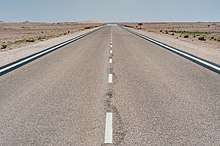Sawda Natheel
| Sawda Natheel سودا نثيل | |
|---|---|
| Village | |
 Sawda Natheel | |
| Coordinates: 24°34′06″N 51°04′06″E / 24.56833°N 51.06833°ECoordinates: 24°34′06″N 51°04′06″E / 24.56833°N 51.06833°E | |
| Country | Qatar |
| Municipality | Al Rayyan |
| Area | |
| • Total | 566.7 km2 (218.8 sq mi) |
| Population (2015)[1] | |
| • Total | 100 |
| • Density | 0.18/km2 (0.46/sq mi) |

Sawda Natheel is a village in Qatar, located in the municipality of Al Rayyan.[2] It used to be part of the Jariyan al Batnah municipality before the municipality was incorporated into Al Rayyan.[3]
It is a highly undeveloped area, consisting mainly of open desert. Of its 566.7 square km area, only 3 square km of land is under use. Farmland occupies 2 square km and cultural establishments account for the remaining 1 square km.[4] Noteworthy features in the area are a border post separating the southern part of the municipality from Saudi Arabia, a well which the village was named after, and several farms.[5]
Etymology
The settlement derived its name from the local well, which in turn had been named after dark precipitates found in its water. Sawda translates to 'black', while Natheel is an Arabic term used to denote soil deposits found in water obtained from a well.[5] It is also known as 'Markaz [center of] Sawda Natheel'.[5]
Geography
Qatar's capital, Doha, is located at a distance of 115 km to the north-east. Other distances include Abu Samra – 76 km away, Umm Salal Ali – 142 km away, Al Khor – 172 km away, Madinat ash Shamal – 222 km away, Al Wakrah – 130 km away, and Dukhan – 145 km away.[6]
Demographics
As of the 2010 census, the settlement comprised 8 housing units[7] and 9 establishments.[8] There were 15 people living in the settlement, of which 100% were male and 0% were female. Out of the 15 inhabitants, 14 were 20 years of age or older and 1 was under the age of 20. The literacy rate stood at 73.4%.[9]
Employed persons made up 100% of the total population. Females accounted for 0% of the working population, while males accounted for 100% of the working population.[9]
| Year | Population |
|---|---|
| 1986[10] | 270 |
| 1997[11] | 167 |
| 2004[3] | 58 |
| 2010[2] | 15 |
| 2015[1] | 100 |
References
- 1 2 "2015 Population census" (PDF). Ministry of Development Planning and Statistics. April 2015. Retrieved 8 August 2017.
- 1 2 "2010 population census" (PDF). Qatar Statistics Authority. Retrieved 29 June 2015.
- 1 2 "2004 population census". Qatar Statistics Authority. Retrieved 1 July 2015.
- ↑ "Broad Land Use Categories by Zone 2015". Ministry of Development Planning and Statistics. Retrieved 27 August 2018.
- 1 2 3 Jacques LeBlanc (March 2008). "A fossil hunting guide to the tertiary formations of Qatar, Middle East".
- ↑ "Qatar in Figures" (PDF). Ministry of Development Planning and Statistics. 2015. p. 9. Retrieved 7 July 2018.
- ↑ "Housing units, by type of unit and zone (April 2010)" (PDF). Qatar Statistics Authority. Retrieved 7 August 2015.
- ↑ "Establishments by status of establishment and zone (April 2010)" (PDF). Qatar Statistics Authority. Retrieved 7 August 2015.
- 1 2 "Geo Statistics Application". Ministry of Development Planning and Statistics. Archived from the original on 11 September 2012. Retrieved 7 August 2015.
- ↑ "1986 population census" (PDF). Qatar Statistics Authority. Archived from the original (PDF) on 3 July 2015. Retrieved 2 July 2015.
- ↑ "1997 population census" (PDF). Qatar Statistics Authority. Archived from the original (PDF) on 29 May 2015. Retrieved 2 July 2015.